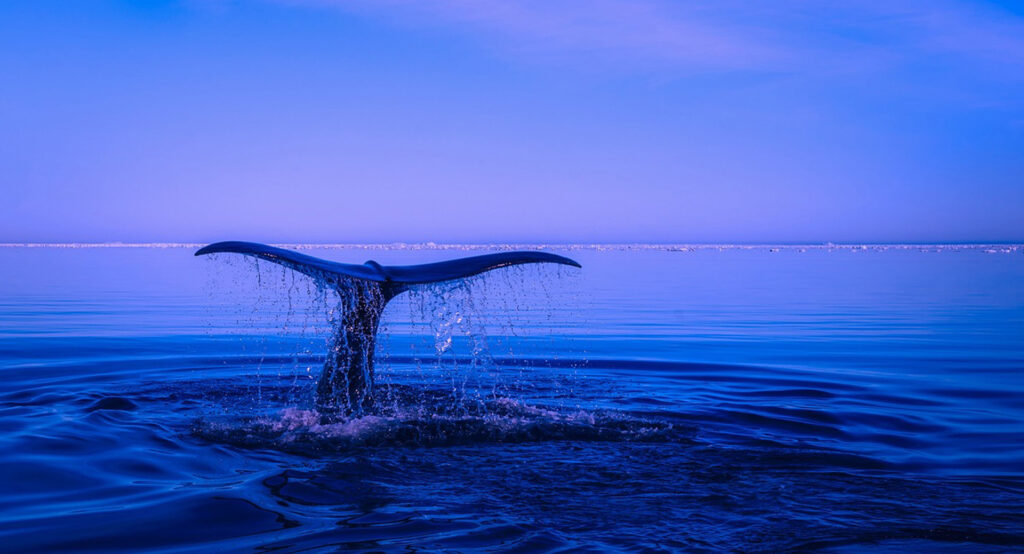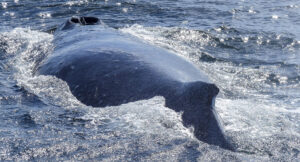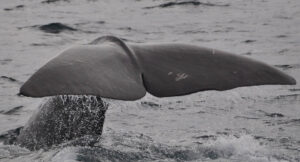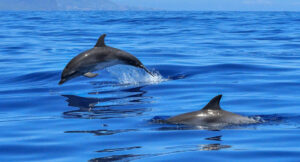18 Amazing Facts About Whales That Will Take Your Breath Away
The majestic creatures of the sea, whales, have captivated humans for centuries with their sheer size and grace. From the haunting sounds of their songs to their breath taking breaches, these creatures never fail to leave us in awe. Here are some fascinating facts about whales:

Whales are the largest animals on Earth, with some species reaching lengths of up to 100 feet and weights of up to 200 tons.
1 The blue whale, in particular, is the largest animal ever known to have existed, with adult individuals reaching lengths of up to 100 feet and weights of up to 200 tons.
Even their hearts alone can weigh as much as a car, and their tongues can weigh as much as an elephant!
There are two main types of whales: toothed whales and baleen whales.
2 Toothed whales, as their name suggests, have teeth in their mouth, and they include species such as killer whales, dolphins, and sperm whales. Baleen whales, on the other hand, have baleen plates in their mouths, which they use to filter small animals such as krill from the water.
Baleen whales include species such as humpback whales, blue whales, and gray whales.
Whales are found in all of the world’s oceans.
3 From the Arctic to the Antarctic, as well as in some rivers and estuaries. Some species of whales, such as the humpback whale, undertake long migrations between their summer feeding grounds in the polar regions and their winter breeding grounds in warmer waters.
Other species, such as the beluga whale, are more restricted in their distribution and are found only in specific regions of the world’s oceans.
Whales are mammals.
4 Which means that they are warm-blooded, breathe air, have hair or fur, and give birth to live young. Like all mammals, whales nurse their young with milk.
Despite their adaptations for life in the water, whales still need to come to the surface to breathe air, and they have lungs instead of gills like fish. However, whales have several unique adaptations for life in the water, such as a streamlined body shape, blubber for insulation, and the ability to hold their breath for long periods of time.
Some species of whales are able to dive to incredible depths in search of food or to avoid predators.
5 The Cuvier’s beaked whale, for example, is known to be able to dive to depths of up to 9,800 feet (3,000 meters), which is deeper than any other mammal on Earth.
 Sperm whales are also known for their deep diving abilities, and have been recorded diving to depths of up to 7,380 feet (2,250 meters).
Sperm whales are also known for their deep diving abilities, and have been recorded diving to depths of up to 7,380 feet (2,250 meters).
During these deep dives, whales must contend with extreme pressure, cold temperatures, and low oxygen levels, and have several adaptations to help them survive in these conditions, such as collapsible lungs and the ability to store large amounts of oxygen in their muscles.
Whales are social animals and often travel in groups called pods.
6 These pods can range in size from just a few individuals to several dozen or even hundreds of individuals, depending on the species.
Some species of whales are known for their tight-knit family groups, with multiple generations of whales traveling together and cooperating to find food and protect each other from predators.
For example, female killer whales live in stable family groups known as “pods” that are led by a dominant female, or “matriarch”.
Other species of whales, such as humpback whales, are known for their complex vocalizations, which may be used for communication within the pod.
Whales may also form temporary associations with other pods or species of whales, and there is some evidence to suggest that whales may even form friendships with individuals outside of their own species.
Many species of whales are endangered due to hunting, habitat loss, pollution, and climate change.
7 One of the biggest historical threats to whale populations was commercial whaling, which decimated many whale populations around the world.
Although most commercial whaling has been banned since the 1980s, some countries continue to hunt whales under the guise of “scientific research”.
Other threats to whale populations include habitat loss and degradation, pollution, and climate change.
For example, noise pollution from shipping and military activities can disrupt whale communication and feeding behaviours, while plastic pollution can harm whales through ingestion or entanglement.
Climate change is also a major threat to whale populations, as rising temperatures and changes in ocean chemistry can impact the availability of prey and alter migration patterns.
Conservation efforts are underway to protect whale populations and their habitats, but much work remains to be done to ensure the survival of these magnificent creatures.
Whales are important to the ocean’s ecosystem.
8 They play a vital role in maintaining a healthy balance of marine life. As top predators, whales help to regulate the populations of their prey species, such as krill and small fish, which in turn can impact the entire food chain.
Additionally, when whales feed at the surface, they often create “whale pumps”, which bring nutrients from the deep ocean to the surface and help to support the growth of phytoplankton, which are the base of the marine food chain.
Whale carcasses are also an important source of food and nutrients for other marine organisms, and can support entire ecosystems of scavengers and decomposers.
In addition to their ecological importance, whales have significant cultural and economic value for many human communities, and are a source of inspiration and wonder for people around the world.
Whales communicate with each other using a variety of vocalizations, including songs, clicks, and whistles.
9 Some species of whales, such as humpback whales, are known for their complex and beautiful songs, which can last for hours and are thought to play a role in courtship and mating.
Other species of whales, such as sperm whales and some species of dolphins, use clicks and whistles to echolocate and find prey in the dark depths of the ocean.
Whale vocalizations can be incredibly diverse and sophisticated, and scientists are still working to understand the full extent of their communication abilities.
In recent years, advances in technology have allowed researchers to study whale vocalizations in more detail, and some studies have even suggested that individual whales may have their own unique “dialects” of vocalizations, similar to human regional accents.
Whale watching is a popular activity around the world.
10 Millions of people each year taking boat tours to see these incredible creatures in their natural habitat. Whale watching can be an exciting and educational experience, and can help to raise awareness about the importance of whale conservation.
However, it’s important to approach whale watching responsibly, as getting too close to whales can disturb their natural behaviour and potentially harm them.
In many countries, there are regulations in place to ensure that whale watching is conducted in a safe and responsible manner, such as maintaining a safe distance from whales and limiting the number of boats in the area.
Additionally, some whale watching tours are designed to be more eco-friendly and sustainable, such as using quieter, low-impact boats or supporting research and conservation efforts.
By enjoying whale watching in a responsible way, we can help to protect these amazing creatures for future generations to enjoy.
Whales are some of the loudest animals on the planet.
11 They are known for their complex and distinctive vocalizations, which they use for communication, navigation, and hunting.
Some species can produce sounds that are among the loudest of any animal. For example, sperm whales are known for their clicks, which they use to echolocate and find prey in the dark depths of the ocean.
These clicks can be as loud as 230 decibels at close range, which is louder than a jet engine! Humpback whales are also known for their complex and beautiful songs, which can be heard for miles underwater.
Some whale species can produce sounds that are so loud they can be heard for hundreds of miles underwater. The blue whale, for example, can produce vocalizations that reach up to 188 decibels, making it the loudest animal on Earth.
Whales produce sounds through their blowholes, which are located on top of their heads. They use a variety of vocalizations, including songs, whistles, and clicks, to communicate with one another and navigate through their environment.
Scientists are still studying the many different ways in which whales use sound, and the study of whale vocalizations, known as bioacoustics, has become an important field of research in recent years.
Whales are known for their exceptionally long lifespans compared to most other animals on the planet.
12 Different species of whales have different lifespans, but some whales can live for several decades or even more than a century. For example, bowhead whales are known to live for over 200 years, making them the longest-living mammals on Earth.
Other whale species, such as humpback whales and sperm whales, can also live for several decades. Female humpback whales have been known to live for up to 50 years, while male humpback whales can live up to 40 years. Sperm whales, on the other hand, can live for up to 70 years.
The long lifespan of whales is believed to be due to their large size and slow metabolism, which results in a lower risk of disease and a longer lifespan.
Additionally, many whales live in protected environments, such as marine reserves and national parks, where they are less likely to face threats from humans, which can also contribute to their long lifespans.
The oil and blubber of some whale species, such as the sperm whale, have been highly valued by humans for centuries.
13 Sperm whale oil, also known as spermaceti, was highly prized for its use in candles, cosmetics, and lubricants during the 18th and 19th centuries. The oil was extracted from the whale’s head, which contains a large cavity filled with a waxy substance that can be refined into spermaceti oil.
In addition to spermaceti, the blubber of some whale species, including the bowhead whale, has also been used for a variety of purposes.
The Inuit people of Alaska and Canada, for example, have traditionally relied on bowhead whale blubber for food, fuel, and building materials. The blubber can also be rendered into oil, which has been used for lighting and cooking.
Whaling for these valuable resources caused a significant decline in whale populations in the 19th and early 20th centuries.
Today, many countries have implemented strict regulations on whaling and the international trade in whale products is banned under the Convention on International Trade in Endangered Species (CITES).
Whales are known to be highly intelligent animals.
14 Whales have large brains relative to their body size, and their brains are highly developed in areas related to social behaviour, communication, and problem-solving.
 Some species of whales, such as the orca or killer whale, are known to have intricate family structures and social relationships, and are believed to have their own unique cultures, passed down from generation to generation.
Some species of whales, such as the orca or killer whale, are known to have intricate family structures and social relationships, and are believed to have their own unique cultures, passed down from generation to generation.
Whales also have sophisticated communication abilities, using a variety of vocalizations to communicate with each other over long distances.
These vocalizations, including songs, whistles, and clicks, are thought to convey a wide range of information about their environment, social structure, and behaviour.
In addition, some species of whales have been observed exhibiting complex problem-solving and tool use behaviours.
For example, some orcas have been observed using their powerful tails to create waves that knock seals off ice floes, while others have been seen using sticks to dislodge prey from crevices.The intelligence and complex behaviours of whales make them a fascinating subject of study for scientists, and research into their cognitive abilities and social structures continues to uncover new insights into these amazing animals.
Whales play an important role in nutrient cycling in the ocean, which helps to support the health of marine ecosystems.
15 When whales feed, they consume large quantities of nutrients in the form of plankton and small fish.
They then excrete these nutrients in their waste, which is rich in nitrogen and other essential nutrients. This whale waste, known as “whale poop,” sinks to the bottom of the ocean and provides a source of nutrients for deep-sea organisms, such as phytoplankton and krill.
In addition, when whales die, their bodies sink to the ocean floor and provide a source of nutrients for a wide range of deep-sea organisms, including scavengers and decomposers.
This process, known as “whale fall,” creates unique habitats on the ocean floor that support diverse and specialized ecosystems.
The role of whales in nutrient cycling is especially important in areas of the ocean that are nutrient-poor, such as the open ocean. By redistributing nutrients from the surface to the deep sea, whales help to support the productivity and health of marine ecosystems.
The decline in whale populations due to commercial whaling and other human activities has had significant impacts on nutrient cycling in the ocean and the health of marine ecosystems.
Efforts to protect and conserve whale populations are critical for maintaining the health and productivity of the world’s oceans.
Whales are threatened by a range of human activities, including commercial whaling, climate change, pollution, habitat loss, and collisions with ships.
16 Commercial whaling, which was once a major threat to whale populations, has been largely banned through international agreements such as the International Whaling Commission (IWC).
However, some countries continue to hunt whales under the guise of scientific research or cultural traditions, and illegal hunting of whales also occurs in some parts of the world.
Climate change is also a significant threat to whale populations, as rising temperatures and ocean acidification can disrupt the food chain and alter the distribution and abundance of whale prey.
Changes in ocean currents and temperatures can also affect whale migration patterns and reproductive success.
 Pollution, including plastic waste, oil spills, and chemical pollutants, can also have harmful effects on whales and their ecosystems. These pollutants can accumulate in the bodies of whales and cause a range of health problems, including reproductive failure and immune system suppression.
Pollution, including plastic waste, oil spills, and chemical pollutants, can also have harmful effects on whales and their ecosystems. These pollutants can accumulate in the bodies of whales and cause a range of health problems, including reproductive failure and immune system suppression.
Habitat loss, due to coastal development, shipping, and noise pollution from human activities, can also disrupt whale behaviour and migration patterns. Collisions with ships are another threat to whale populations, especially in areas of high shipping traffic.
Efforts to protect and conserve whale populations, including through international agreements, protected areas, and reduced human impacts on the ocean environment, are critical for ensuring the survival of these magnificent animals.
Whales do not typically attack submarines or any other human vessels.
17 In fact, whales generally try to avoid contact with humans and their vessels.
Whales are known to be curious and may approach boats and submarines out of curiosity or to investigate their surroundings. However, they typically do not show any signs of aggression towards these vessels and will often swim away if they feel threatened or uncomfortable.
There have been a few reported incidents of whales accidentally colliding with submarines or other vessels, which can be dangerous for both the whale and the crew of the vessel. However, these collisions are rare and are typically accidental, rather than intentional.
It’s important to remember that whales are wild animals and should be treated with respect and caution. Boaters and submariners should always keep a safe distance from whales and other marine mammals, and should never attempt to approach or interact with them in any way that could cause harm or disturbance.
There are around 90 different species of whales
18 Dolphins, and porpoises, which are collectively known as cetaceans. These species can be divided into two main groups: baleen whales and toothed whales.
 Baleen whales, such as humpback whales and blue whales, have a series of plates made of keratin, known as baleen, in their mouths that they use to filter out small prey from seawater.
Baleen whales, such as humpback whales and blue whales, have a series of plates made of keratin, known as baleen, in their mouths that they use to filter out small prey from seawater.
Toothed whales, such as killer whales and sperm whales, have teeth and feed on larger prey, such as fish, squid, and other marine mammals.
Other types of cetaceans include porpoises, which are smaller than most dolphins and have a blunt snout, and dolphins, which are highly social and intelligent animals known for their acrobatic leaps and clicks and whistles that they use to communicate with each other.
Each species of whale has its own unique characteristics, including size, shape, behavior, and habitat. Some species, such as the blue whale, are among the largest animals on Earth, while others, such as the vaquita, are critically endangered and may soon become extinct.



